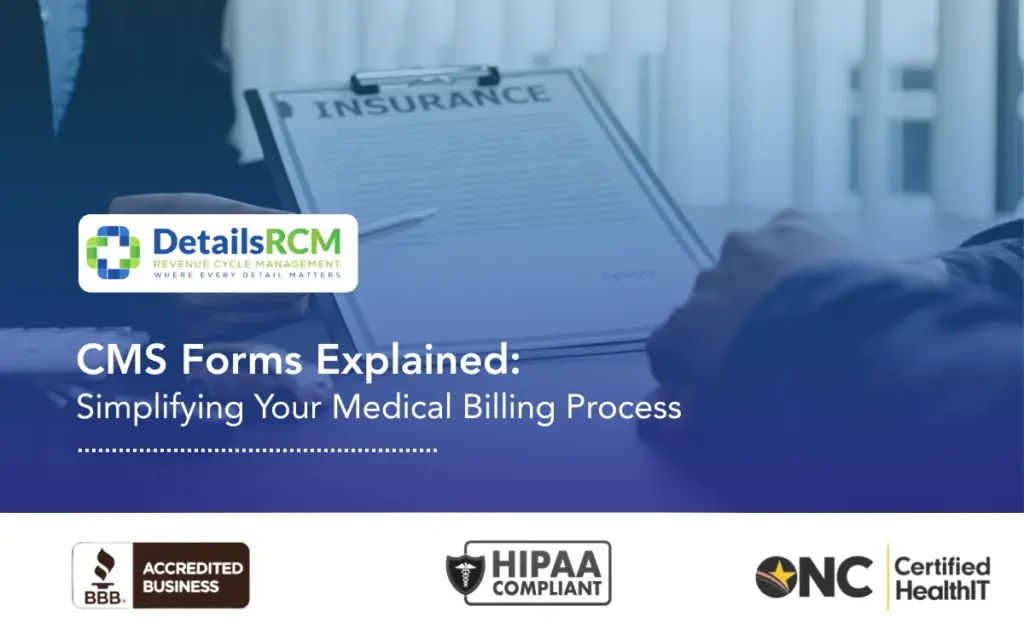In the complex world of medical billing and healthcare RCM administration, certain forms and documents are critical for smooth operations and compliance. One such essential document is the CMS form. If you’re new to medical billing or want to understand this better, this blog post will walk you through what a CMS form is, why it matters, and how it’s used.
What Does CMS Stand For?
CMS stands for the Centers for Medicare & Medicaid Services, the U.S. federal agency responsible for administering the nation’s major healthcare programs, including Medicare, Medicaid, and the Children’s Health Insurance Program (CHIP). CMS plays a pivotal role in healthcare billing, regulations, and compliance.
What Is a CMS Form?
A CMS form refers to any standardized form created or mandated by the Centers for Medicare & Medicaid Services for various administrative and billing purposes. These forms help healthcare providers, insurance companies, and patients submit and process claims, authorize treatments, and comply with federal healthcare regulations.
Common Examples of CMS Forms in Medical Billing
- CMS-1500 Form: This is the most commonly used form for billing professional medical services and supplies to Medicare, Medicaid, and many private insurers. It’s used primarily by individual healthcare providers and non-institutional providers (such as doctors, therapists, and clinics).
- CMS-1450 Form (UB-04): This form is used by institutional providers such as hospitals, skilled nursing facilities, and hospice providers to bill Medicare and other payers.
- CMS-837: An electronic version of the paper claim forms (CMS-1500 and UB-04) used in electronic data interchange (EDI) for submitting healthcare claims electronically.
Why Are CMS Forms Important?
- Standardization: CMS forms provide a standardized format that helps streamline billing processes. This reduces errors and speeds up claims processing.
- Compliance: Using the correct CMS form ensures providers meet Medicare and Medicaid regulations, reducing the risk of denied claims and audits.
- Data Accuracy: These forms collect critical patient, provider, diagnosis, and procedure information that payers need to adjudicate claims correctly.
How CMS Forms Are Used in Medical Billing
When a healthcare provider delivers services, they use CMS forms to submit claims for reimbursement. Here’s a brief overview of the process:
- Documentation: The provider documents patient care, diagnoses, and procedures performed.
- Claim Preparation: The billing team completes the appropriate CMS form, entering detailed information like patient demographics, provider identifiers, diagnosis codes, procedure codes (CPT/HCPCS), and charges.
- Submission: The claim is submitted either on paper (rare today) or electronically (via CMS-837 format) to Medicare, Medicaid, or commercial payers.
- Adjudication: The payer reviews the claim for completeness, accuracy, and medical necessity before approving or denying payment.
- Payment or Follow-up: Once approved, payment is issued. If denied, the provider follows up to resolve issues or appeal.
Tips for Handling CMS Forms Efficiently
- Stay Updated: CMS regularly updates forms and instructions. Make sure your billing team uses the latest versions to avoid delays.
- Accuracy is Key: Double-check all data entries including codes, patient info, and provider details to prevent denials.
- Use Electronic Claims: Whenever possible, submit claims electronically using CMS-837 to speed up processing and reduce paperwork.
- Train Staff: Regular training on CMS forms and billing procedures improves accuracy and compliance.
Conclusion
CMS forms are foundational in the medical billing process, ensuring that healthcare providers get reimbursed correctly and promptly while staying compliant with federal regulations. Understanding these forms—especially the CMS-1500 and CMS-1450—is essential for anyone involved in medical billing and healthcare administration.


